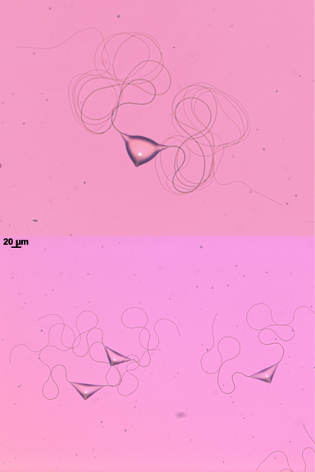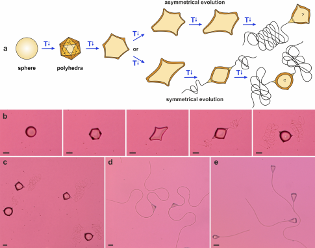Emulsion microdroplets can swim by producing their own flagella
2021-07-15

Researchers from the Faculty of Physics at the University of Warsaw, University of Cambridge, Queen Mary University of London and University of Sofia have shown that slow cooling of a suspension of oil droplets with surfactant in water may lead to non-spherical shapes of the droplets, which can produce filamentous structures resembling bacterial flagella. The filaments induce motion of the droplets, and the process is fully reversible via cyclic changes of the temperature of their environment. An article describing the findings has just been published in “Nature Physics”.
The new research article by researchers from the Faculty of Physics of the University of Warsaw, University of Cambridge, Queen Mary University of London and University of Sofia has been published in Nature Physics. It explores the behaviour of a suspension of oil microdroplets with the addition of a surfactant in water. The droplets have a diameter of about 20 micrometres, so they are visible under a microscope. When steadily cooling the droplets, at temperatures close to 2-8 degrees Celsius, the surfactant molecules inside the oil droplets start forming a plastic phase and by that deforming the droplets in such a way that they start extruding elongated filament-like structures at one or a few spots on the surface. The extrusion of elastic appendages induces motion of the droplets in a way similar to the motion of microscopic swimmers, such as bacteria.
“We present a new class of active, elastic microswimmers produced by simply cooling a 3-component emulsion. They are easy to control and cheap to fabricate” says Dr. Maciej Lisicki from the Faculty of Physics, University of Warsaw. “By changing the external temperature and controlling the cooling rate we are able to see the formation of intricate and beautiful geometric structures resembling flagella of swimming microorganisms”. Surfactants used in this study are biocompatible and the system could be useful for further studies of the dynamics of active matter, particularly in mixed systems of artificial and biological microswimmers to investigate collective effects.

“By coupling the buckling instability with filament extrusion we reveal the details of this mode of swimming, which provides new insights into the motion of microswimmers”. Dr. Lisicki adds. “Using the theoretical tools of microscale fluid dynamics, we are able to understand why these tails form, explain their shapes, and quantify the resulting motion of the droplets”.
The work results from a long-standing international collaboration between researchers from Poland, Bulgaria, and the United Kingdom. The droplets were synthesised and experiments were performed by the team led by Prof. Nikolai Denkov at the University of Sofia, in collaboration with the group of Dr. Stoyan Smoukov at Queen Mary University of London. The description of motion in such a system requires considering both the elastic deformation of the filaments, and their hydrodynamic resistance. The model predicts the swimming speed of the oil droplets depending on the elastic properties of the solidified filaments. The theoretical model describing the dynamics of these novel active particles was constructed by Dr. Maciej Lisicki (Warsaw), Dr. Gabriele De Canio and Prof. Eric Lauga (Cambridge).
Physics and Astronomy first appeared at the University of Warsaw in 1816, under the then Faculty of Philosophy. In 1825 the Astronomical Observatory was established. Currently, the Faculty of Physics' Institutes include Experimental Physics, Theoretical Physics, Geophysics, Department of Mathematical Methods and an Astronomical Observatory. Research covers almost all areas of modern physics, on scales from the quantum to the cosmological. The Faculty's research and teaching staff includes ca. 200 university teachers, of which 81 are employees with the title of professor. The Faculty of Physics, University of Warsaw, is attended by ca. 1000 students and more than 170 doctoral students.
SCIENTIFIC PAPERS:
‘Rechargeable self-assembled droplet microswimmers driven by surface phase transitions’
Diana Cholakova, Maciej Lisicki, Stoyan K. Smoukov, Slavka Tcholakova, E Emily Lin, Jianxin Chen, Gabriele De Canio, Eric Lauga, and Nikolai Denkov
Nature Physics (2021).
https://www.nature.com/articles/s41567-021-01291-3
CONTACTS:
Dr. Maciej Lisicki
Institute of Theoretical Physics
Faculty of Physics
University of Warsaw
email: Maciej.Lisicki@fuw.edu.pl
RELATED LINKS:
http://softmatter.fuw.edu.pl
Maciej Lisicki’s homepage
http://www.fuw.edu.pl
The Faculty of Physics, University of Warsaw website
http://www.fuw.edu.pl/informacje-prasowe.html
Press office of the Faculty of Physics, University of Warsaw
IMAGES:
FUW210715b_fot01
https://www.fuw.edu.pl/tl_files/press/images/2021/FUW210715b_fot01.jpg
While cooled, droplets of oil in an aqueous surfactant solution may form two tail-like filaments produced by extruding the material from inside of the droplet. Before the process starts, the droplets take polygonal shapes because of the formation of a plastic phase of the freezing surfactant. The initially straight filament undergoes a buckling instability and its final shape results from an interplay between its elasticity and hydrodynamic resistance of the fluid. (Image credit: D. Cholakova, University of Sofia)
FUW210715b_fot01
https://www.fuw.edu.pl/tl_files/press/images/2021/FUW210715b_fot02.png
Upon cooling, emulsion droplets deform and finally produce one or two filaments. The schematics (a) show the transformation of an initially spherical drop into a swimmer, passing through a series of shape changes controlled by a surface phase transition of the detergent. (b-e) Series of swimmers with different shapes and swimming properties. The type of oil and surfactant used determine the elastic properties of the filaments. (Image credit: Nature Physics publication (2021))
MOVIE:
FUW210715c_mov01
https://www.fuw.edu.pl/tl_files/press/images/2021/FUW210715c_mov01.avi
The filaments extruded by the droplets induce swimming motion of the droplets in a manner similar to microscopic swimming organisms, such as bacteria and ciliates. This simple artificial design can give us new insights into the physics of microscale swimming. (Video credit: D. Cholakova, University of Sofia)





